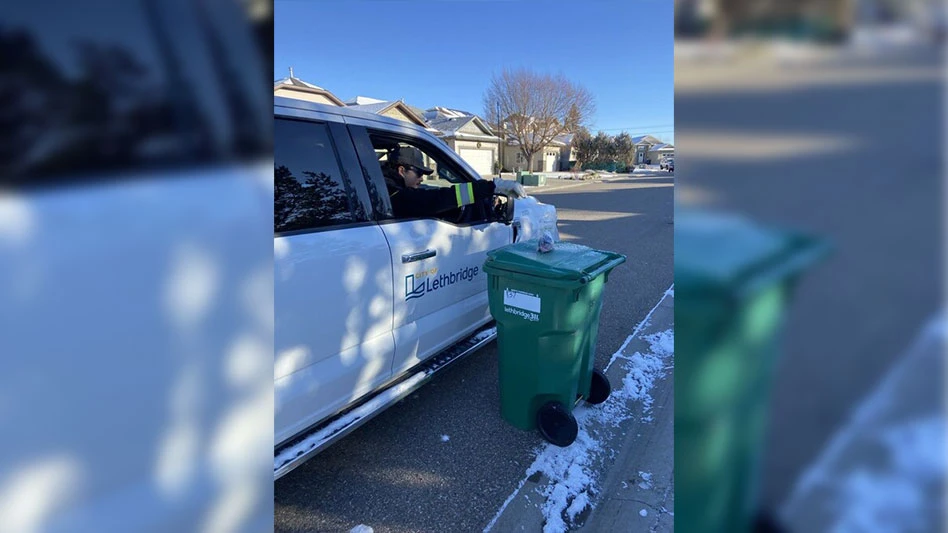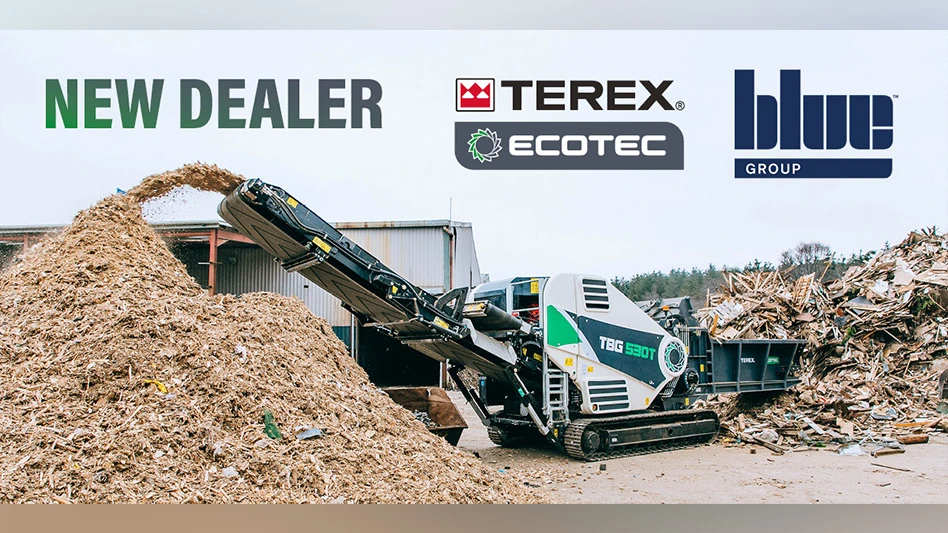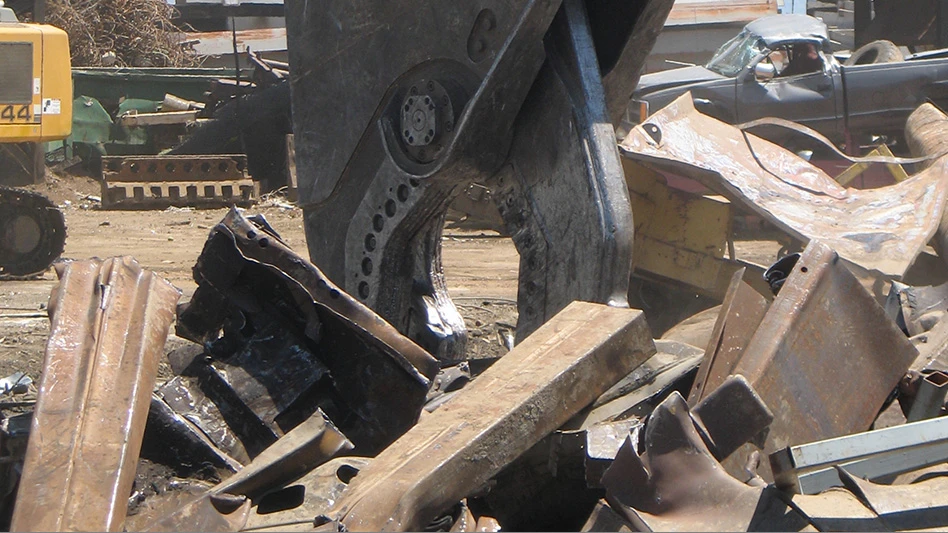The skid steer loader might best be described as a generalist. It was designed to do no one thing that can’t be done by other machines, but it is also designed to do several things productively.
According to both recyclers and equipment manufacturers, machines in the skid steer category offer distinct advantages in the performance of several common tasks. Far and away, they are most commonly associated with moving and loading materials such as scrap metals, used beverage cans (UBCs), scrap paper, and scrap plastic.
By the Bucket Load
The attachment that is standard on original equipment skid steers is the loading bucket. As the full name "skid steer loader" implies, the operation of the bucket is the primary task facing most skid steers each day.
While larger machines such as wheel loaders and cranes are capable of moving vastly greater amounts of material in one cycle, skid steers can still accomplish many loading and moving tasks quickly and affordably.
Increasingly, new models are being introduced by manufacturers that are just a little bit larger and capable of loading just a few pounds more material than their predecessors.
"We prefer to have a machine with some girth to it," acknowledges Tony Benacquisto, executive vice president at Ferrous Processing & Trading Co., Detroit.
"We have probably about a dozen skid steers," he notes, saying the fleet consists of both Bobcat and Mustang brand models. "Generally, we use them in the nonferrous end of our business, moving things like copper, brass and cable."
With the exception of one broom attachment that is sometimes used for clean-up purposes, the diesel-powered fleet stays equipped with buckets, says Benacquisto.
Case Corp., Racine, Wisc., now produces a line of skid steers with load limits significantly higher than earlier models. The Case XT line features skid steers with a range of load limits from 1,750 pounds to 3,650 pounds. The largest machine in this line—the Case 95XT—has been marketed to the scrap recycling segment due to its lift capacity and its heavy suit of armor.
The 95XT has a uni-body chassis with reinforced stress points. There are no welds near high-stress areas of the machine, while parts of the machine are protected with ½-inch-thick steel.
All of the XT models are being marketed as high-capacity machines in small bodies. The newest in the line is the smallest of the four. "The Case 75XT is a high-capacity machine in a compact package," says Case Corp. marketing manager Lee Callaway.
New Holland North America Inc., New Holland, Pa., is likewise producing models with an increased ability to lift and load. "New Holland has experienced tremendous growth in the demand for our largest skid-steer loaders—the 2,200-pound rated operating capacity Models L/Lx865 and Lx886," says skid steer loader product manager John Osarczuk. "But our customers have asked for even more performance in the same rugged, compact and comfortable package."
The company’s new Lx985 has a 2,800-pound rated operating load capacity that can be extended to 3,200 pounds when rear counterweights are added.
Gehl Co., West Bend, Wisc., markets its 35 Series toward the scrap recycling market. The 6635 is the line’s largest model, with a lifting capacity of 2,600 pounds if counterweights are ordered. "The new Deutz engines deliver the power needed for increased performance, faster ground speed and the extra muscle to power more hydraulic attachments," Gehl Co. product manager Kelly Moore says.
Productivity in the form of how much can be lifted and dropped in a given amount of time is still the key factor in how skid steer performance is measured. New Holland’s Osarczuk touts the new Lx985 in those terms. "Greater lift capacity and dump height, lower center of gravity, longer wheelbase and higher ground speed all translate to one main advantage to our customers—pure productivity."
Changing Attachments
While buckets are standard, virtually all skid steers are now designed to accept other attachments.
Recognizing that scrap facility operators utilize several types of attachments in the course of processing materials, skid steer manufacturers are beginning to market the change-out capabilities of their machines.
"These days, skid steers aren’t simply used for moving materials," says Case Corp.’s Callaway. "With the vast array of attachments available, they are serving as highly versatile tool carriers. This allows owners to maximize profits," he adds.
Case and its allied supplier companies now offer more than 75 attachments that are approved for use with the Case 1800 and XT series skid steers, according to Callaway. While that assortment includes many attachments with few or no recycling applications, it also includes a variety of buckets, grapples, shears, hammers and other pieces of equipment that find uses in scrap and recycling facilities.
Manufacturers now make certain to assure potential customers that their skid steers are designed to make changing attachments a simple, quick process.
Case Corp. says its skid steers are available with couplers designed to allow for the fast, easy exchange of attachments. Daewoo Heavy Industries America Corp., Suwanee, Ga., says its newest skid steer model—the 1760XL—has a "universal attachment system that makes it compatible with most attachments available today."
Hydra-Mac, an Eagan, Minn.-based maker of small skid steers, recently entered the mid-sized market with the 2050 model, which it says features a "totally compatible attachment frame" that allows for the mounting of most attachments in the market.
Beyond being able to change quickly, attachments with hydraulic requirements need to be able to operate effectively. Case offers what it calls a "high-flow" kit that can be ordered with most of its skid steers. The option doubles available hydraulic flow to attachments. "The high-flow kits really maximize the capabilities of a skid-steer loader," says Callaway. "It also makes possible the use of larger, more powerful attachments."
Attachments need not be complex to have value at many facilities, however. Some processors have found that attaching forks to skid steers provides them with a rugged, durable machine that can lift containerized materials.
According to Harry Carbo, maintenance supervisor at Ben Shemper & Sons Inc., Hattiesburg, Miss., four of the five skid steers used at his company’s processing facilities are equipped with forks. The remaining skid steer is most often equipped with a bucket.
"We use four John Deere 544 series models with forks on them," says Carbo. "They move a little bit of everything: pipe, containers of stainless steel, copper, brass. We also can use them to lift auto hulks," he notes.
At Midland Davis Corp. in Moline, Ill., a small fleet of Bobcat skid steers is used for a variety of tasks utilizing different attachments. The company processes ferrous scrap and also operates a paper recycling facility. The skid steers can be found at the paper facility, according to company co-owner Marty Davis. "We have three Bobcat skid steers at our paper recycling plant and we use them for everything," says Davis. "One with a bucket is used for handling loose paper to place it onto the conveyor," he notes. "We also equip them with forks. We find they offer more maneuverability than most forklifts would be able to provide," Davis adds.
The company also operates a wood grinding business that will perform work off-site, primarily grinding wood pallets at the locations of industrial and warehouse clients. "In our wood grinding business, we have a skid steer that goes along with our tub grinder out to job sites. The skid steer, equipped with a grapple bucket, hauls the pallets to the tub grinder. We also have a sweeper attachment for when we’re done, to pick up the resulting sawdust. The change-out takes just a couple of minutes," Davis notes.
Navigating Narrow Channels
The nimble quality of skid steers has helped them gain favor at both low-volume and high-volume scrap processing yards, as well as at MRFs, paper packing plants and virtually any other recycling facility.
With their ability to move quickly and compactly through narrow rows and aisles, the machines are perfect for recyclers working in areas offering limited turning ratios. Skid steers are designed to rotate, pivot and turn sharply in all directions, making them ideally suited not only for warehouses, but also at applications such as MRFs and paper packing plants where space can be tight.
At larger facilities or outdoor yards, skid steers can offer a mobility advantage to go along with maneuverability. While many skid steer models do not claim a rated speed of more than about six miles per hour, some newer models are hitting higher speeds. Hydra-Mac’s new 2050 can be ordered with a two-speed transmission that lets the machine travel at 12 miles per hour. The Case 90XT and 95XT skid steers can also be ordered with enough horsepower to let them reach 11 miles per hour.
But even when marketing the larger, more powerful machines, manufacturers are quick to note that they offer the traditional maneuverability advantages associated with skid steers. "Don’t let its long wheelbase fool you," Case Corp. says of its 95XT. "The 95XT is compact enough to get you in and around confined areas that bigger machines can’t, especially with its zero-radius turning; just right for working in recycling yards."
Surviving a Daily Beating
As the cage the operator sits in implies, a skid steer is likely to face some tough circumstances on any given day. In scrap and recycling applications, the risks can include sharp, jagged metal, broken glass, rough terrain, and flying bits of debris.
Manufacturers, parts suppliers and processors have all worked on ways to address the problem of operating mobile equipment such as skid steers in the harsh scrap environment.
Makers of skid steers offer models with thicker steel and other features that can make them endure the tough conditions. Virtually every skid steer brochure and press release touts the heavy plate steel found in the model being described.
But even the protective features may not be enough to prevent a mishap that will result in downtime. The importance of routine maintenance should also not be overlooked, since downtime can just easily be the result of an engine or hydraulic system problem.
Among common problems that can cause downtime, tire damage certainly ranks high on the list of potential pitfalls. The availability of solid tires and damage-resistant pneumatic tires has helped decrease the problem.
Why are skid steers so tough on tires? "The name skid steer explains it really," says Bennie McGill, a district manufacturer’s representative with SETCO Solid Tire & Rim Assembly, Idabel, Okla. "The machine is either spinning tires or sliding tires in order to move. It’s the only machine that can spin a 360 without ever getting out of the circle."
Add to the rubber-burning nature of the machines the existence of sharp jagged metal, and tires can become a threatened species.
McGill claims that at one scrap facility he recently visited, the skid steers were operating on air-filled radial tires and were averaging more than one flat tire per day.
What causes the damage? "All kinds of metal and objects," says McGill, "including nuts, bolts, driveshafts, starters, and shredded automobiles." He also notes that skid steer tires also face rough going at glass recycling facilities and in demolition applications.
Damage can occur above the tires as well. "Operators really have to watch for wire wrapping around the drivelines," says Carbo, the scrap facility maintenance supervisor. "You have to cut the wire manually, and it’s a time-consuming process. You can’t torch it because of the hydraulic lines that are there. Meanwhile, you’ve got a $30,000 piece of equipment sitting around not making money."
It can be argued that a few such incidents are bound to happen at locations where jagged metal or broken glass are part of the landscape. A facet over which skid steer owners have more control is the maintenance of their machines.
"The life expectancy of all equipment has to do with maintenance," declares Carbo. "It’s up to us to make sure it all keeps running," he says of his maintenance staff at Ben Shemper & Sons.
Although it is almost universally derided by those who are stuck behind their desks doing it, maintaining proper maintenance records—paperwork—is a key to keeping machines humming, Carbo contends. "You have to keep up with it. You have to keep decent records. As much as a pain as it is, you have to do the paperwork."
Brand Loyalty
Carbo notes that being a brand loyalist can offer some advantages when it comes to operating more than one skid steer. In the case of Ben Shemper & Sons, the skid steer fleet strictly consists of five John Deere 544 series skid steers.
"When you own several similar pieces of equipment, you like to stick with one kind. It makes it easier from a maintenance viewpoint," says Carbo. "You try to be as standardized as possible. Stocking parts is much easier. Plus, when you get good service out of someone, why change?"
Skid steer manufacturers and operators seem to agree that properly maintained skid steers can last a number of years and log a lot of operating hours.
"They last a long time," says Marty Davis of the Bobcat skid steers his company has owned. "We may have replaced all our original ones by now, and upgraded in size from the 700 series to the 800 and 900 series, but they have a very long life span."
At Ben Shemper & Sons, Carbo says of the John Deere fleet, "our 544Es are about seven years old. We still have in our fleet a 544T, which is about eight years old, and one 544 C which I believe is from the 1979 model year."
Despite the harshness encountered at scrap and recycling facilities, the pint-sized workhorses known as skid steers can hold their own and live to work another day.
The author is editor of
Recycling Today.Sidebar:
A Considerable Presence
Balers, shredders, and the cranes that most often feed them may be considered the indispensable prerequisites for a scrap facility, but skid steers maintain a considerable presence in the industry.
In 1997, Recycling Today conducted a survey of more than 120 scrap and recycling facility operators. Nearly 50% of the respondents operated one or more skid steers, and in most cases, more than one.
At that time, respondents were also making plans to buy more skid steer loaders. Slightly more than 10% of the 120 recyclers were shopping for new skid steers, with another 5% saying they were in the market for a pre-owned model.
By brand name, Melroe/Bobcat had the leading presence at scrap and recycling facilities, followed by Case, Mustang and New Holland. Also present in the market were Caterpillar, Gehl, John Deere and several other manufacturers.
Only a handful of respondents claimed to have a regular replacement schedule for trading in old or buying new skid steers. Of those that did, a four-year cycle was most common, with an average operating hour range of 5,000 to 6,000 operating hours.

Explore the November 1998 Issue
Check out more from this issue and find your next story to read.
Latest from Recycling Today
- Phoenix Technologies closes Ohio rPET facility
- EPA selects 2 governments in Pennsylvania to receive recycling, waste grants
- NWRA Florida Chapter announces 2025 Legislative Champion Awards
- Goldman Sachs Research: Copper prices to decline in 2026
- Tomra opens London RVM showroom
- Ball Corp. makes European investment
- Harbor Logistics adds business development executive
- Emerald Packaging replaces more than 1M pounds of virgin plastic





